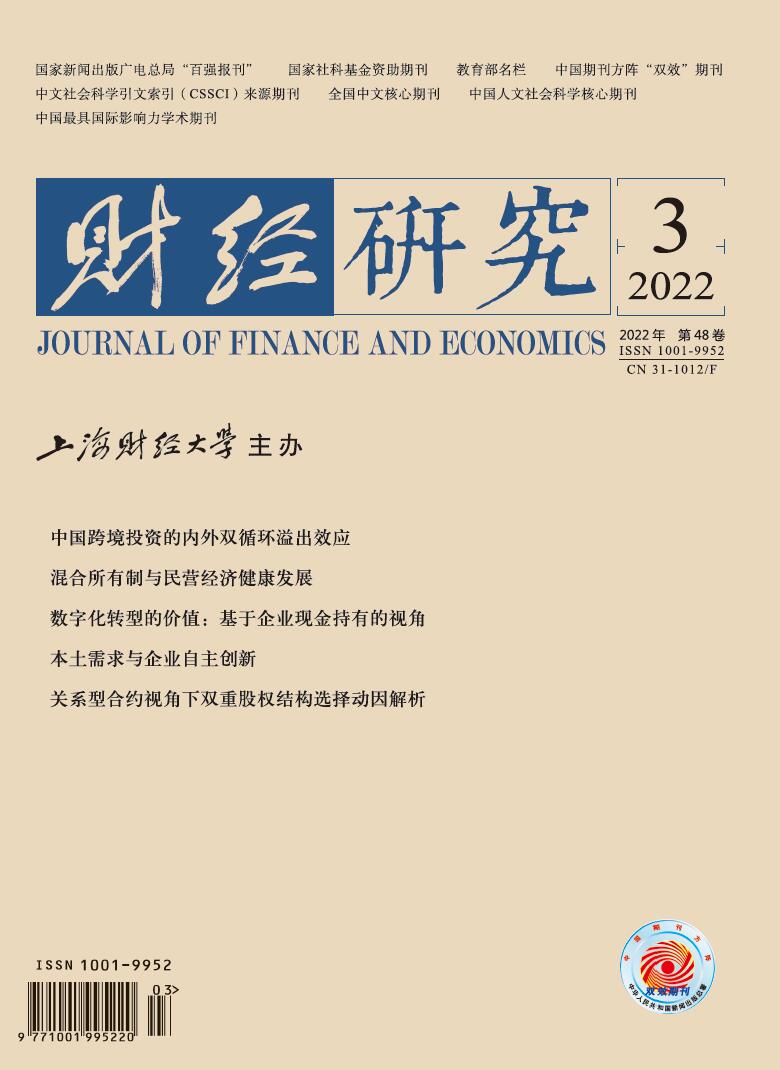揭示并验证双向跨境投资驱动内外双循环的动态溢出效应及其互动影响,对推动高层次全面开放、破解单边贸易保护主义制约至关重要。文章基于内外双循环机制,构建中国与其他国家之间的双向跨境投资互动溢出模型,以省际面板数据和跨国面板数据实证检验发现:在内循环阶段,其他国家对中国跨境投资在高强度情况下能够双向激励国内经济增长与技术进步;在外循环阶段,中国对其他国家跨境投资的外向经济溢出效应逐渐转化为技术溢出效应;内外双循环彼此衔接,强化“走出去”能够撬动并放大“引进来”的内向经济溢出效应和技术溢出效应;其他国家对中国的跨境投资有利于逆向释放外循环的多边技术溢出效应。进一步对比分析还发现,高强度的双向跨境投资对经济增长和内生增长的双轨溢出红利仅在发展中国家有效;在“一带一路”建设引领下,沿线国家之间的双向跨境投资有利于获得积极的技术溢出红利。上述结论为击破“中国威胁论”、扩大开放经济影响力、以内外双循环推动全球治理新格局,提供了丰富而有力的实证依据。
中国跨境投资的内外双循环溢出效应
摘要
参考文献
6 李磊,冼国明,包群. “引进来”是否促进了“走出去”?−外商投资对中国企业对外直接投资的影响[J]. 经济研究,2018,(3):142−156. DOI:10.3969/j.issn.1672-5719.2018.03.127
8 刘建丽. 新中国利用外资70年:历程、效应与主要经验[J]. 管理世界,2019,(11):19−37. DOI:10.3969/j.issn.1002-5502.2019.11.003
13 孙攀,丁伊宁,吴玉鸣. 中国双向FDI协调发展与经济增长相互影响吗?−基于“双循环”背景的实证检验[J]. 上海经济研究,2021,(2):98−111. DOI:10.3969/j.issn.1005-1309.2021.02.009
14 田红彬,郝雯雯. FDI、环境规制与绿色创新效率[J]. 中国软科学,2020,(8):174−183. DOI:10.3969/j.issn.1002-9753.2020.08.016
16 张岳然,费瑾. 双边投资协定、东道国制度环境与中国对外直接投资区位选择[J]. 世界经济与政治论坛,2020,(6):116−141. DOI:10.3969/j.issn.1007-1369.2020.06.007
18 Adom P K, Opoku E E O, Yan I K M. Energy demand-FDI nexus in Africa: Do FDIs induce dichotomous paths?[J]. Energy Economics,2019,81: 928−941. DOI:10.1016/j.eneco.2019.05.030
20 Damijan J P, Polanec S, Prašnikar J. Outward FDI and productivity: Micro-evidence from Slovenia[J]. The World Economy,2007,30(1): 135−155. DOI:10.1111/j.1467-9701.2007.00876.x
21 Elia S, Mariotti I, Piscitello L. The impact of outward FDI on the home country’s labour demand and skill composition[J]. International Business Review,2009,18(4): 357−372. DOI:10.1016/j.ibusrev.2009.04.001
22 Hansen H, Rand J. On the causal links between FDI and growth in developing countries[J]. The World Economy,2006,29(1): 21−41. DOI:10.1111/j.1467-9701.2006.00756.x
23 Hayakawa K, Lee H H, Park D. Are investment promotion agencies effective in promoting outward foreign direct investment? The cases of Japan and Korea[J]. Asian Economic Journal,2014,28(2): 111−138. DOI:10.1111/asej.12030
24 Helpman E. Trade, FDI, and the organization of firms[J]. Journal of Economic Literature,2006,44(3): 589−630. DOI:10.1257/jel.44.3.589
25 Huang C H, Teng K F, Tsai P L. Inward and outward foreign direct investment and poverty: East Asia vs. Latin America[J]. Review of World Economics,2010,146(4): 763−779. DOI:10.1007/s10290-010-0069-3
26 Khoury T A, Peng M W. Does institutional reform of intellectual property rights lead to more inbound FDI? Evidence from Latin America and the Caribbean[J]. Journal of World Business,2011,46(3): 337−345. DOI:10.1016/j.jwb.2010.07.015
27 Lucchetti R, Palomba G. Nonlinear adjustment in US Bond Yields: An empirical model with conditional heteroskedasticity[J]. Economic Modelling,2009,26(3): 659−667. DOI:10.1016/j.econmod.2009.01.013
28 Nidhiprabha B. The rise and fall of Thailand's export-oriented industries[J]. Asian Economic Papers,2017,16(3): 128−150. DOI:10.1162/asep_a_00556
29 Nwaogu U G, Ryan M. Spatial interdependence in US outward FDI into Africa, Latin America and the Caribbean[J]. The World Economy,2014,37(9): 1267−1289. DOI:10.1111/twec.12118
30 Piperopoulos P, Wu J, Wang C Q. Outward FDI, location choices and innovation performance of emerging market enterprises[J]. Research Policy,2018,47(1): 232−240. DOI:10.1016/j.respol.2017.11.001
31 Seong Y J, Jung J S. Determinants of Korean Firm's outward foreign direct investment: Based on empirical test by TPP countries[J]. International Business Review,2017,21(1): 49−68. DOI:10.21739/IBR.2017.03.21.1.49
32 Stoian C, Filippaios F. Dunning's eclectic paradigm: A holistic, yet context specific framework for analysing the determinants of outward FDI: Evidence from international Greek investments[J]. International Business Review,2008,17(3): 349−367. DOI:10.1016/j.ibusrev.2007.12.005
33 Thangavelu S M, Yong Y W, Chongvilaivan A. FDI, growth and the Asian financial crisis: The experience of selected Asian Countries[J]. The World Economy,2009,32(10): 1461−1477. DOI:10.1111/j.1467-9701.2009.01202.x
引用本文
李勃昕, 张玉荣, 朱承亮, 等. 中国跨境投资的内外双循环溢出效应[J]. 财经研究, 2022, 48(3): 4-18.
导出参考文献,格式为:





 5518
5518  5641
5641

